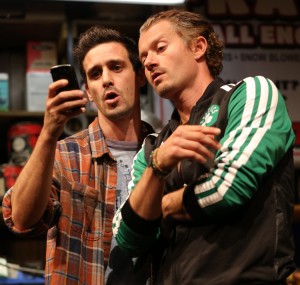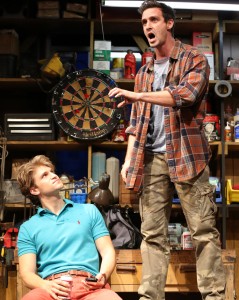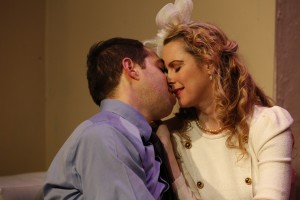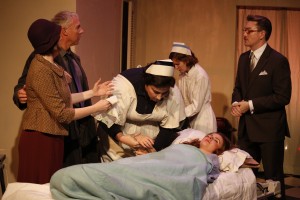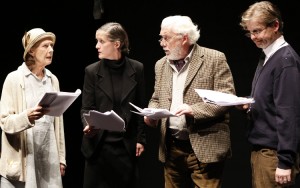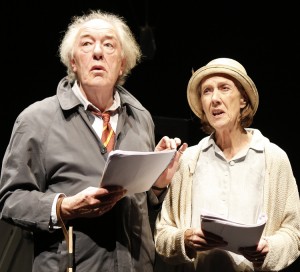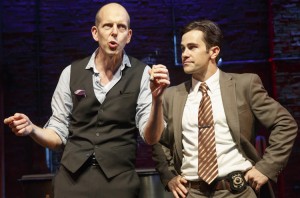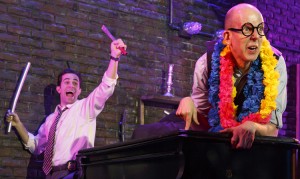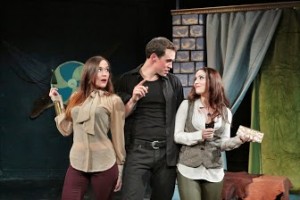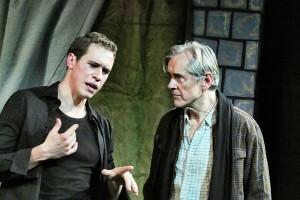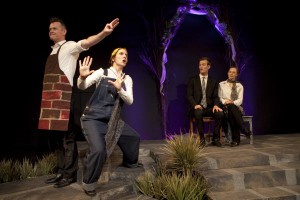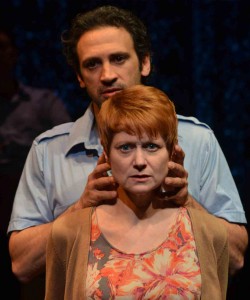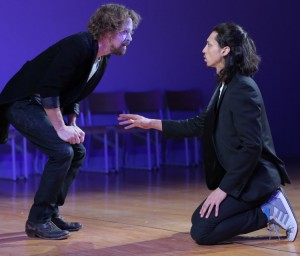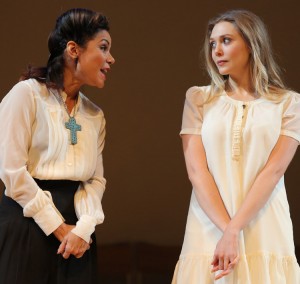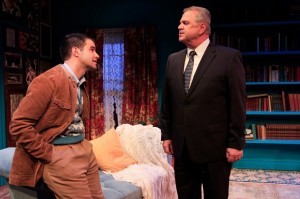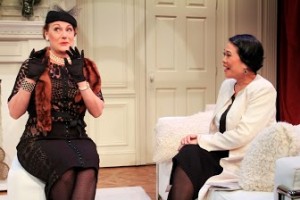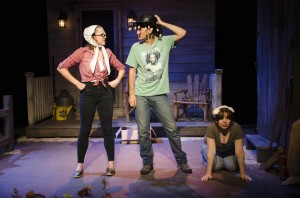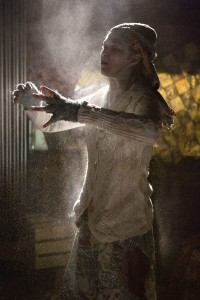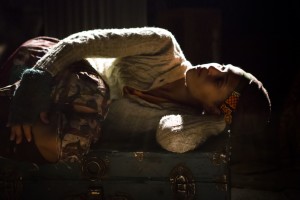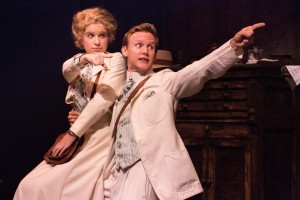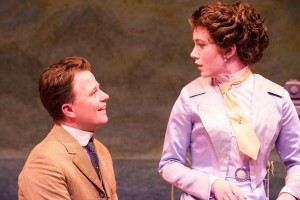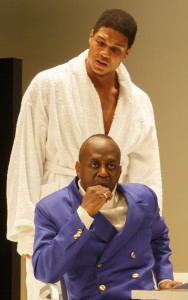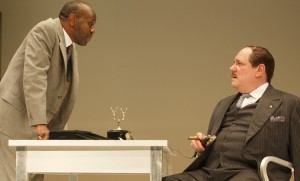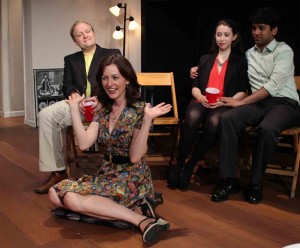Entering the Minetta Lane Theatre last Saturday night for Nutcracker Rouge, I was not quite sure what to expect. I first heard of Company XIV just two years ago and soon became familiar with their growing reputation for borrowing from multiple performative traditions and taking them to another level. The company, brainchild of art director/choreographer/founder Austin McCormick, is an acclaimed multidisciplinary troupe whose unique blend of jazz, opera, vaudeville, burlesque and old-time theatrics have been shaking up the theater scene since its founding in 2006.
Trash Talkers' Tale
John Pollono’s résumé indicates he has had some notable acting appearances, but his new play, Small Engine Repair, provides evidence that he also has a fine sense of dramaturgy. Director Jo Bonney’s swift 90-minute production gives four actors an opportunity to showcase some ethnic characters with swagger and distinctive accents. Needing only one set, Small Engine Repair should not only provide a healthy income for Pollono as he pursues a career either in acting or writing, or both, but also give audiences a good time.
Set in the titled enterprise, in Manchester, N.H., the play quickly establishes an atmosphere of foul-mouthed comic insult hurled by macho dolts, and then lingers there awhile. Frank (Pollono), the owner, has invited his childhood friends of 30 years, Packie (James Ransone) and Swaino (James Badge Dale), to stop by. But neither Packie nor Swaino, whose last interaction resulted in a violent falling-out over cough drops, knows the other is coming. When Swaino arrives, Frank attempts to play mediator as they begin drinking some expensive scotch that Frank has bought, ostensibly to help effect a reconciliation.
Loaded with scabrous, Mamet-like dialogue, the play recalls American Buffalo, also about three small-time working-class strugglers, in its vulgar brio. The junk shop in Mamet’s play has its counterpart in Frank's cluttered workspace, designed superbly by Richard Hoover with oil cans, jacks, wrenches, screwdrivers and a sliding entry door.
For a while, Pollono's Frank plays the centered straight man to his goofier colleagues, bringing a solidity and a dark undercurrent to the character. And gradually it becomes apparent that the men's bawdy discussion of women, pornography and prostitutes is linked to the playwright's theme. Pollono has something to say about men’s callous treatment of women and the way social media have exacerbated a viral atmosphere of disdain toward them. Typical of the men's mindset is the preening Swaino’s answer to whether he has been in touch with an ex-girlfriend: “I kind of lost contact with her after I stopped calling.”
Swaino sees himself as a ladies’ man, but no sane woman would want him for a long-term relationship. Dale plays him all-out, with slicked-back, curly, graying hair, a tracksuit with the top open halfway down his chest, and Buddhist mala beads on his wrists (Theresa Squire did the costumes) — he’s a borderline caricature of someone who sees himself as God’s gift to women.
Ransone is equally fine as the quick-tempered, put-upon Packie, who laments his lack of money and attributes it to being Irish: “My people were oppressed by white men,” he declares in all sincerity. And his heritage brings some serious teasing by Swaino, who calls him a “leprechaun” and says: “You got no reason to be angry at me, Packie. I don’t got no pot of gold.” Packie, whose slighter build is derided but who has an enviable sexual organ, is also tech-savvy — and it's one of his saving graces.
A late twist (you may guess it before it arrives) propels the play into violence, and the resolution, lewd and comical, involves Packie and some crucial lighting by Lap Chi Chu. One of the pleasures of Small Engine Repair is that its heroes may be losers and jerks, but the world is full of much worse.
Small Engine Repair will play through Dec. 15. Evening performances are: Tuesday through Thursday at 7 p.m.; Friday and Saturday at 8 p.m. Matinees are Saturday at 2 p.m. and Sunday at 3 p.m. There is an additional performance on Monday, Nov. 25, at 7 p.m. General tickets are $69-$89 and may be purchased by calling 212-352-3101 or visiting www.mcctheater.org.
The Fervent Years Revived
At the curtain call of Sidney Kingsley's medical-crisis drama Men in White, a member of the Off-Off Broadway troupe The Seeing Place brandishes a clear-glass vase containing a little bit of folding money and assures the house that any contributions, however modest, will be appreciated. That polite solicitation is a reminder that it takes more than let's-put-on-a-show energy (which the cast has in abundance) to keep a theater company afloat. In the words of its promotional literature, the 27-member Seeing Place (that's a literal translation of the classical Greek noun theatron) is an "actor-driven company: built by actors, managed by actors to be a base for actors who want to grow and hone their craft in a creative and supportive artistic home." Men in White is the first of five socially conscious plays that The Seeing Place is offering as its fifth season.
Back in 1933, Men in White was the first successful production of another "actor-driven company" — the Group Theatre, which flourished in New York for most of the Great Depression. The play won the Pulitzer Prize; and, in 1934, MGM released a movie version starring Clark Gable and Myrna Loy. Over the years, Men in White has inspired hospital dramas on television from Ben Casey and Dr. Kildare to ER and Grey's Anatomy. (Kingsley's Detective Story has similarly provided a template for police dramas up to the present, with the Law and Order and CSI franchises.) The Seeing Place production is the first professional revival of Men in White in New York in three decades.
Set during the Depression, Men in White portrays life at various levels of St. George's, a cash-strapped private hospital in Manhattan. The protagonist, Dr. George Ferguson (Brandon Walker), is a high-minded intern of unusual promise, engaged to a socially-ambitious woman (Erin Cronican) whose father (Stewart Steinberg) is a benefactor of St. George's. Distressed by conflicting demands from his all-consuming vocation and his possessive fiancée, Ferguson turns for momentary sympathy to a nurse (Martine Moore) who shares his altruistic views. Predictably enough, melodramatic complications ensue. What's surprising is that Kingsley's old-fashioned dramaturgy raises issues — the ethics of abortion, for instance, and how healthcare should be financed — that are as urgent now as they were 80 years ago.
The narrative of Men in White is engaging; but the play is of interest principally because it's linked inextricably to the Group, a collective of actors, directors and writers inspired by the ideas of actor-director Konstantin Stanislavsky and committed to producing plays of social significance. The Moscow Art Theatre, which Stanislavsky co-founded, visited the United States a decade before the Group produced Men in White; its performances on Broadway and elsewhere during that tour had a profound effect on both playgoers and theater professionals. The New Republic critic Stark Young, who saw the troupe in January 1923, describes their work as "that rarest of events in the theatre anywhere, the combination of acting, producing and dramatic writing, one proceeding from another and all illuminating one idea."
The Group's production of Men in White was directed by Lee Strasberg, who later, as artistic director of the Actors Studio, would become the chief proponent of method acting. The cast included future acting gurus Sanford Meisner and Robert Lewis; future director Elia Kazan; and Clifford Odets, who would write the Group's greatest plays, Awake and Sing!, Waiting for Lefty and Golden Boy. The scenic designs by the distinguished Mordecai Gorelik included an operating-room set, innovatively lighted, for the crucial surgery scene, which was staged in a fashion that critics described as "balletic." Reviewing Men in White in The Nation, Joseph Wood Krutch said: "The effectiveness of the production can be credited less to any one element in it than to its remarkable wholeness, to the way in which everything in the acting and direction, as well as in the script itself, works with everything else to produce an unbroken continuity of interest and to leave behind a complete unified impression."
With its huge cast and complex staging demands, Men in White is a massive undertaking. The ostensive magic of the Group's original production was a function of gifted actors working full-time (unhindered by "days jobs"), with ample rehearsal time, since the collective-bargaining agreements of that era were less restrictive than those of today. Treading in the footprints of the Group Theatre is a daunting notion. The Seeing Place is to be commended for staging Men in White on a tight budget, with 16 actors covering 27 roles; and there's much that's admirable about what the cast accomplishes. Walker, in particular, gives a strong, thoughtful performance as Dr. Ferguson; and he's well-matched by Cronican in their several scenes together. Serving as both leading lady and director, however, Cronican may be on stage too much to have the bird's eye view necessary to direct a script as complicated as this one. The chaos of the climactic operating room scene, for instance, might have been averted if Cronican had viewed things from afar rather than being stuck in the center of the onstage action.
This presentation of Men in White doesn't approach the "remarkable wholeness" and "unified impression" that Krutch so admired in the Group's staging — the cast is uneven; what's suspenseful in the script is undercut by erratic pacing; even the Prokofiev that serves as entr'acte music is out of kilter with the mood of the dramatic material. But, for those interested in 20th-century drama, this is an opportunity, at a mere $12 per ticket, to experience a milestone work of the 1930s that's now nearly forgotten. And there's a plucky spirit to the production that's in sync with those Depression-era pioneers who founded the Group. That plea for donations at the curtain call, with the clear-glass vase and its small amount of folding money, is more than a testament to the difficulty of creating an environment in which artists may develop serious work in this costly city. It's a declaration that the theater deserves both passion and sacrifice.
Men in White by Sidney Kingsley presented by The Seeing Place at The Sargent Theater (in the American Theater of Actors, 314 West 54th Street) runs Wednesdays through Saturdays at 8 p.m., Saturdays and Sundays at 2 p.m., through Sunday, November 24. General admission $12.
Life's Bitter Dregs
The correspondence of director Alan Schneider and his friend Samuel Beckett indicates that the Irish playwright never wanted his radio play All That Fall adapted for theatrical presentation. His response to an overture by Schneider, entrusted with numerous Beckett plays during the author’s lifetime, including Waiting for Godot, indicates Beckett’s final decision was essentially “Let it stay as it is.”
Happily, British director Trevor Nunn hasn’t heeded that advice, and his stage adaptation works wonderfully well. How to turn a radio play into a piece of theater? Set it in a radio station with the actors portraying actual voice performers. Cherry Truluck’s set features 10 microphones hanging from the ceilings in a zigzag pattern in a gray room. A half dozen chairs on either side of the room allow for sitting for the actors as they await their cues, and recording is signaled by a red light over an upstage door. For verisimilitude, Paul Groothuis’s sound effects don’t always synchronize with the actors. As Eileen Atkins’s Mrs. Rooney trudges in the studio, after all, her actual footsteps don’t need to be aligned with the scraping sounds provided for radio listeners. Nunn’s ingenious concept allows the play to breathe for the stage.
It helps that Nunn has assembled a sterling cast, headed by acting legends Atkins and Michael Gambon as her blind, irascible husband. The action consists of Mrs. Rooney’s walk to the train station to meet her husband’s train, and their walk back to their home in a storm. But there’s no mistake that this is a Beckett play: it’s bleak and funny; it mocks religion, underlines the misery of life, and leaves you in an exhilarated funk. If you’re new to Beckett and want to just dip your toe in, these 75 minutes are a good way to start.
As Mrs. Rooney sets out, she meets various residents of her Irish village. There’s Christy (Ruairi Conaghan), driving a cart with a donkey that he beats, upsetting Mrs. Rooney: “No, no, enough! Take her by the snaffle and pull her eyes away from me. Oh this is awful!” The theme of life itself as a painful burden arises again when she encounters Mr. Slocum (Trevor Cooper) in his car. After a comical interlude with Slocum trying to push Mrs. Rooney into the car and finally succeeding, he runs over a chicken. “What a death!” cries Mrs. Rooney. “One minute picking happy at the dung, on the road, in the sun, with now and then a dust bath, and then — bang! — all her troubles over.”
But even the routine inquiries about loved ones elicit unhappy news. When she meets a bicyclist, Mr. Tyler (Frank Grimes), she asks, “What news of your poor daughter?” “Fair, fair,” he responds. “They removed everything, you know, the whole...er…bag of tricks. Now I am grandchildless.” Near the end of the play she asks a young boy, Jerry, “How is your poor father?” and Jerry answers, “They took him away, Ma’am.” “Then you are all alone?” she asks. “Yes, Ma’am,” says the boy.
Though the existential woes are relentless, they mix cheek by jowl with comedy. The kind but unappreciated Slocum at one point sits in silence, prompting Mrs. Rooney to ask, “What are you doing, Mr. Slocum?” Slocum’s deadpan answer: “Gazing straight before me, Mrs. Rooney, through the windscreen, into the void.”
Religion, too, takes a hit. Discussing the vicar’s text for the Sunday service, Mrs. Rooney tells her husband, “The Lord upholdeth all that fall and raiseth up all those that be bowed down” (Psalm 145:14). There’s a pause as Gambon’s gruff, boisterous Rooney and his wife take it in, then they erupt in derisive laughter.
Beckett aficionados will recognize recurring elements from other plays: a young boy, Jerry, echoes the messenger boy in Waiting for Godot; Mr. Rooney is blind, just as Hamm in Endgame (played terrifically in a 2004 West End production by Gambon, who wore dark glasses) and Pozzo in Godot; a reference to a ditch calls to mind the same in Godot. Some of the writing is obviously mordantly funny; not so obvious is what an actress like Atkins can make of a simple line such as “Do you want some dung?”
Gambon makes a relatively late entrance, but provides a solid foil to Atkins’s worn down, caviling wife. The blind Mr. Rooney rails like Lear, and it is surely no accident that they make their way through a pelting rain to get home. It makes one realize that Gloucester’s line “As flies to wanton boys are we to th' gods/They kill us for their sport” might have been written by Beckett rather than Shakespeare.
All That Fall plays through Dec. 8. Evening performances are Tuesday through Thursday at 7 p.m. and Friday and Saturday at 8 p.m. Matinees are Wednesday and Saturday at 2 p.m. and Sunday at 3 p.m. There will be no performance on Thanksgiving Day, Nov. 28. Single tickets are $70 and may be purchased by calling Ticket Central at 212-279-4200 or going to www.59e59.org.
Killer Performers in a Mock Mystery
Two consummately talented singer-actors shine bright in Murder for Two, a musical mystery from Second Stage that has moved to New World Stages in midtown after a summer run on the Upper West Side. While it’s ideal brainless summer fun, it’s a bit riskier to put on amid autumn’s weightier offerings, but director Scott Schwartz’s nifty production makes one hope there is an audience for light-headed laughter at any time of year.
In Joe Kinosian and Kellen Blair’s book, the set-up is hoary — guests invited to an isolated rambling mansion, a killer on the loose, a variety of suspects (think of Agatha Christie’s Ten Little Indians, invoked here, or Neil Simon’s film Murder by Death). But add a sparkling score (music by Kinosian; lyrics by Blair) and two performers, Jeff Blumenkrantz and Brett Ryback, who have a fine way with a Steinway, and you’re halfway there — if “there” is a frenetic parody of all the murder mystery tropes, you can tick off from the top of your head.
The victim is famed novelist Arthur Whitney, whose birthday was to be celebrated in a posh affair organized by his simmeringly resentful wife, Dahlia. The guests include Barrette Lewis, a haughty, glamorous ballerina; Murray and Barb, a squabbling married couple; Dr. Griff, a blabby psychiatrist; three kids (Timmy, Yonkers and Skid) from a choir in Badoinkaville, which is apparently equivalent to the Lower East Side in Collarhorn, the fictional small-town setting; and a bewildered firefighter who makes a brief appearance.
Moreover, there is Dahlia Whitney, the loopy socialite widow, and her niece Steph, an ambitious college student interested in law enforcement whose thesis is “How to Assist in the Solving of a Small-Town Murder.” If you think that Jefferson Mays, who is playing a mere eight characters in A Gentleman’s Guide to Love and Murder on Broadway, has a challenge, check out Blumenkrantz, who plays all 12 suspects.
Opposite Blumenkrantz is a charismatic Ryback as Officer Marcus Moscowicz, a straight-arrow policeman bucking for detective, though he carries emotional scars. He’s supposed to secure the scene, but, mistaken for the expected detective, he seizes the opportunity to solve the crime before the official sleuth arrives. His only backup is another officer, Lou, seen only in silhouette, thanks to Jason Lyons’ inventive lighting.
A tone of one-upmanship is set immediately, as Ryback and Blumenkrantz have a tug-of-war over removing the piano cover. But despite the tomfoolery, they both sound great on the eighty-eight, and that includes not only their nimble fingers but Ryback’s rear end and Blumenkrantz’s feet.
The backstage set by Beowulf Borritt is apt but unprepossessing: a trunk, some cables, and an outline of a mansion that, lighted by Lyons, casts a looming shadow on the upstage wall. Blumenkrantz adopts various voices, postures, and pitches for his characters (not to mention vocalizing a creaking door), and adds a gesture to complete the characterizations: a sweep of the hand on imaginary hair for Steph; a pair of black-rimmed glasses for Dahlia; and a cigar and raspy voice for Dr. Griff. And, as one of the kids, he dances a Charleston on his knees.
Schwartz’s pacing resembles a Marx Brothers movie (a piano duet has a sly homage to Chico Marx), and it works most of the time. Occasionally Blumenkrantz’s switching of characters is a bit confusing, and some of the low comedy is as old as vaudeville — a light bulb on the proscenium arch goes on when Marcus gets an idea — but, for the most part, the hijinks are fun. If breaking the fourth wall seems routine and the firefighter scene feels like filler, those are quibbles.
On the plus side, Kinosian has a gift for writing catchy melodies, and Blair’s lyrics display a naughty wit. When Marcus worries that Timmy, Yonkers and Skid may suffer emotionally from seeing blood and Arthur Whitney’s corpse, they reassure him they’re survivors (literally) in a song called “A Lot Woise”:
“Went on a camping trip and lost nine members of the choir there
When our tent was set on fire there,
Yeah, we seen a lot woise.
"I can’t imagine how my best pal Johnny musta felt that night
When his face began to melt that night,
Boy, we seen a lot woise.”
A two-character show can’t work, though, without virtuosity in the performers, and both Ryback and Blumenkrantz make one hope to see much more of them, on a larger stage and a bigger budget. For now, though, it’s enough just to make their acquaintance.
Murder for Two will play at New World Stages, Stage 5, 340 W. 50th St., through Jan. 5. Evening performances are Thursday-Saturday at 8 p.m.; Wednesday and Sunday at 7 p.m.. Matinees are Wednesday and Saturday at 2 p.m. and Sunday at 3 p.m.
Hamlet on the Upper West Side
The Tragical History of Hamlet, Prince of Denmark is the longest of William Shakespeare’s 36 plays and probably the most complex. In the four centuries since the Lord Chamberlain’s Men (the band of players to which the Bard belonged) first presented Hamlet, critics have expended countless gallons of ink debating the play's strengths and flaws. Harold Bloom calls Hamlet “our world’s most advanced drama, imitated but scarcely transcended by Ibsen, Chekhov, Pirandello and Beckett.” T.S. Eliot finds the play “puzzling” and “disquieting,” and declares that, “far from being Shakespeare’s masterpiece,” it's “an artistic failure.” The fact that Hamlet is Shakespeare’s most frequently produced work indicates that audiences, on the whole, are less skeptical of its merits than Eliot.
The contours of Prince Hamlet’s story come from Historia Danica by Saxo Grammaticus and Belleforest's Histoires Tragiques. Shakespeare remolded the existing material to the shape of the English revenge tragedies popular in his day. The result, as always with Shakespeare, is altogether different from the sources on which the playwright drew. In Shakespeare’s version, Hamlet, a student at the University of Wittenberg, has returned to Denmark for his father's funeral. By a ghostly visitation (the Ghost being his father, the late King), Hamlet receives a piece of life-changing news: the King didn’t die from a snakebite, as generally believed; he was poisoned by Claudius, the new king who is Hamlet’s paternal uncle and now his stepfather. The social strictures of the day demand that the son avenge the parent's death; yet, for most of the play, Hamlet procrastinates, keening over his loss, fuming about his mother’s swift re-marriage to the avaricious uncle, pondering mortality and that “undiscovered country from whose bourn / no traveler returns.” He masks his intentions and his real emotions with an "antic disposition."
On Manhattan's Upper West Side, the small, ambitious Frog and Peach Theatre Company is offering Hamlet with a film-noir flavor that enhances the mysterious qualities of Shakespeare's plot and underscores what's most suspenseful in the dialogue. The Frog and Peach Hamlet gets off to a sluggish start but, as the student-prince figures out what's rotten in Denmark, the pace accelerates. After a single intermission (which falls surprisingly early in the proceedings), the action moves with a sense of inexorability toward the company's engrossing enactment of the duel scene, with its moving reversals and many deaths. The cast — six members of the Actors' Equity Association and eight non-union performers — handles Shakespeare’s blank verse competently and, in some cases, with élan.
Brando Boniver plays Hamlet as a straight-shooter who's discovering how deceitful the world can be. He's a meditative sophomore, learning to dissemble for his own protection. Boniver's mixture of naivety and wisdom gives an interesting slant to the Prince's familiar monologues. Imposingly tall and clad, of course, in black, Boniver leavens Hamlet’s melancholy with considerable humor; here and there, he refreshes a well-known line with a dash of Millennial inflection. He delivers the play's most famous soliloquy — "to be, or not to be" — in feigned madness, waltzing Ophelia (Megan McGarvey) around the stage. This unexpected bit of blocking invigorates a passage that's familiar to the point of being stale; and, in this staging, the soliloquy works both as an expression of Hamlet's thoughts on the mortal condition and, from Ophelia's point of view, as a burst of creepy logorrhea about suicide.
As Horatio, Hamlet’s closest friend and the one who survives to tell the Prince's tale, Jonathan Reed Wexler is the very model of loyalty and comradely affection. Of all the cast, Wexler is most at ease with Shakespeare’s iambic pentameter. His unadorned delivery of the "flights of angels" speech, as well as the subsequent lines about the "carnal, bloody and unnatural acts" he has witnessed, provides a moving summary of all the preceding turmoil. It’s tempting to imagine what Wexler's vocal skill, unaffected style, and assured stage presence would bring to the title role.
Director Lynnea Benson has trimmed Shakespeare's text judiciously (the performance runs only slightly more than two and a half hours), and offers some interesting innovations. A single Player (Roger Rathburn) represents the traveling troupe that arrives in Elsinore to "catch the conscience of the King." To make this casting-efficiency work, Horatio joins Rathburn in the play-within-a-play; and Wexler, gussied up in tacky road-show finery, wrings considerable humor out of Horatio's consternation at being pressed by Hamlet into service as an amateur thespian.
Benson has cast Amy Frances Quint and Ilaria Amadasi as Rosencrantz and Guildenstern, Hamlet's supposed-friends from Wittenberg, invited to Denmark by Claudius to spy on the Prince. Quint and Amadasi are a couple of Bond Girls, too mature to be undergraduates (even if Wittenberg had enrolled women in those days). They simper and posture and paw Boniver like a pair of medieval Mrs. Robinsons. This non-traditional casting is a risky directorial gambit; but the louche qualities with which Quint and Amadasi imbue their characters make Rosencrantz and Guildenstern effective foils to Boniver's fundamentally ingenuous Hamlet. In most productions, Hamlet's emotionless sacrifice of the lives of his erstwhile friends is unnerving. In the Frog and Peach production, Quint and Amadasi are cold-hearted foxes outfoxed by the Prince; and their treachery proves a milestone in Hamlet's education about the dark side of humankind. It all makes sense.
Despite a few Nordic touches, the scenic design by Andy Estep is not committed to a particular locale; and the costumes by Lindsey L. Vandevier reflect no particular era. Both scenery and clothes have been managed admirably on a tight budget and, in their simplicity, serve their purpose well. Some weaknesses in the production may be a function of the church-basement nature of the The West End Theatre. Broadway veteran Dennis Parichy has to contend with a primitive lighting system; and the original score by Ian McDonald of King Crimson and Foreigner gets a less-than-fair hearing due to the abruptness of all the sound cues.
By the time Frog and Prince Company finishes its run, there will be other Hamlets competing for attention in the Tri-State area. In the weeks ahead, English actor Rory Kinnear (of Skyfall fame) will be seen in the title role at various cinemas in the region as the Royal National Theatre reprises its worldwide broadcast of the 2010 production; Kevin Kline is including material from Hamlet in his one-man show at the McCarter Theatre Center in Princeton; and the Bedlam Theatre Company will commence an open-ended run of its 4-actor Hamlet at the Culture Project on Bleecker Street. The prevalence of Shakespeare's greatest creation in and around New York this autumn confirms Harold Bloom's declaration: "There is no end to Hamlet or to Hamlet, because there is no end to Shakespeare."
William Shakespeare's Hamlet presented by The Frog and Peach Theatre Company at The West End Theatre (above the Church of St. Paul/St. Andrew, 236 West 86th Street) runs Thursdays, Fridays and Saturdays at 7:30 p.m., Sundays at 3 p.m., through Sunday, November 10. General admission $18; seniors and students $12.
Love and Other Drugs
According to the old adage, “love is blind” – so goes the premise behind Shakespeare’s classic play, A Midsummer Night’s Dream. The Titan Theatre Company’s production expands this idea with the concept of a sort of “blind” casting – that is, having eight of the nine actors’ roles chosen for them by the audience before every performance. Through this method, the notion of love as something that does not discriminate is quite literally put on display and brought to the forefront in ways possibly never before seen with the play. The results, with the company’s talented cast, is a romantic comedy like no other.
For the uninitiated, A Midsummer Night’s Dream tells the tale of a group of young lovers, a pair of which – Theseus, duke of Athens and Hippolyta, queen of the Amazons – are about to embark on their upcoming nuptials. The rest of the lovers find themselves in a love triangle (or perhaps, a love square), as Demetrius pines for Hermia, who is betrothed to Lysander, while Helena yearns for Demetrius’ affections herself. In the midst of all this, a play is scheduled for the wedding celebrations by a group of simpletons: Quince, a carpenter; Flute, a bellows-mender; Snout, a tinker; Snug, a joiner; and Bottom, a weaver. Rounding out this eccentric cast of characters are the creatures of the wooded forests in which much of the action takes place: Puck (also called Robin Goodfellow), a mischievous hobgoblin; his master of sorts, Oberon, king of the fairies; his queen, Titania; and her attendant, Peaseblossom.
It is through Oberon and Titania’s quarrel over the possession of an orphan boy that the plot thickens, as the Fairy King orders Puck to use a flower with magical properties in order to make Titania fall in love with a beast, so as to pluck the orphan from her ownership while she’s in her daze. The two conspirers also happen to witness Helena pursuing Demetrius in the woods, and Oberon orders Puck to cast Demetrius under the spell of the charmed flower. However, while the task of distracting Titania is successfully done (as she falls for Bottom, turned into a donkey after the group’s rehearsal in the woods), Oberon discovers that Puck has mistakenly made Lysander, not Demetrius, fall in love with Helena. So ensues madness of comedic proportions.
Shakespearean actors are often lauded not only for their ability to decipher and interpret the Bard’s language, but also for their sheer ability alone. They are often classically trained, and as such are able to embody these characters and present them to a modern audience with ease and grace. The cast of this production is no exception – in fact, they far exceed all the usual qualities of a Shakespearean actor, given the task thrown at them. The unique casting process challenges each of the eight actors (the character of Puck is always played by the same actor; in this case, by Matthew Foster) to memorize all 16 roles in the play.
While confusing at first, as some of the female roles were played by men and vice versa, switching things up with the casting only helped to further heighten the comedy and eventually made for a great night at the theater. Each actor was given a track of double roles, and each one was astounding in their grasp of each character. Jonathan Matthew Finnegan was wonderfully flamboyant and ever as the scorned lover of Helena (he also played fairy Peaseblossom), while Sean Hudock was adorable in his roles as the romantic Hermia and shy, cowardly Snug. Though perfectly capable as Lysander, it was Lloyd Mulvey’s take on Flute that garnered much laughter, particularly during the “Pyramus and Thisbe” scene. One of the production’s taglines was: Who’s your bottom tonight? – and this night’s Bottom, played by Emily Trask, was the highlight of the evening, as she managed not only to make the audience cry with laughter, but also induce chuckles from her fellow cast mates.
The casting process also gave way to an interesting reinterpretation of the costumes. As no one knew beforehand which roles they were to play, the cast was first introduced to us wearing “uniforms” of white dress shirts and black slacks. Once cast in their roles for the night, their individual costumes were adjusted, with the women wearing skirts and sashes, and the men wearing sweaters and blazers over their outfits. For the lovers, costume designer Scott Frost had each pair wearing corresponding colors, a clever way for the audience to figure out whose true love belongs to whom.
As for the set design, the production went for a minimal yet elegant set befitting a fantastical play such as this, featuring a simple stone-like platform, replete with bits of shrubbery. Alan Pietrowicz’s lighting, most of which consisted of a neon-colored fixture along the back wall (which would change color depending on the scene), as well as overhead lighting, which would dim in order to signify the transition from day into night and therefore setting the tone for the lovers’ trysts in the forest.
The Titan Theatre Company’s rendition of A Midsummer Night's Dream is one that will leave you entranced and thoroughly entertained. With a clever reimagining and talented cast, this is one dream you won’t want to wake up from.
A Midsummer Night's Dream is playing at The Secret Theatre (4402 23rd Street in Long Island City) until November 3, 2013.
The Truth Isn't Easy
The Israeli Arab, Ali Said, says that he met Eileen in the hallway of the Mayfair Hotel; in his account, their eyes met and they went into a room for wild sex. “I’m a wonderful lover. She enjoyed herself,” Ali informs his interrogator, Dov (Ezra Barnes). Not so, Eileen tells Dov in a separate interview. She met him in the park, where he approached her and began a conversation, though it did indeed end in intercourse. She was a virgin, even at fortysomething. No, says Ali, she was definitely not a virgin.
Lucile Lichtblau's play The English Bride is a compact, fascinating play about what we know about people — what anyone can know — and what lies folks will tell and even believe to keep their lives under control. This exercise among three liars, which recalls the classic film Rashomon, is based on a 1986 incident in which a Muslim Arab was arrested for attempting to blow up an El Al flight in Britain. As Dov, an Israeli Mossad agent, interviews the accused bomber and the woman who loved him, he has no qualms about employing lies to find the truth. The structure, a collection of monologues and two-person scenes that unfold as Dov tries to separate the truth from lies, is admirably lean and vigorous in the hands of director Carl Wallnau.
As the meeting and deepening relationship between Ali (Michael Gabriel Goodfriend) and Eileen (Amy Griffin) is recounted, the story appears straightforward. She and Ali have small disagreements — will the child she’s carrying be a boy or a girl? Will it have Eileen’s fair complexion or Ali’s darker skin? Will she agree to wear a veil? Wallnau makes sure that Lichtblau’s plot, which snakes around on itself, delivers all the surprises forcefully — a woman in the audience gasped involuntarily in the last minutes as an important plot point proved shockingly bogus.
Griffin, in the title role of an unprepossessing refugee from the northern British city of Leeds, sports a persuasive regional accent. Eileen talks confidently but masks the desperation of a woman on the cusp of middle age and fleeing a miserable life with a depressing family. Ali’s attraction to her is different from that of other men, she says. “He was different,” she tells Dov. “With him, I always believed down deep he meant what he said even though I never let on to him that I believed him,” adding “my mum used to tell me ‘never trust a man who smiles.’” The last is a nice touch, a suggestion of painful family life and past close-mindedness, and Lichtblau’s understanding of her characters is reflected by several such small moments. One can accept those as facts, but so many others about Eileen are offered and rescinded that one’s head may spin by the end.
Nor is Eileen's story the only fluid one. Ali, played by Goodfriend with initial hostility and then canny charm toward his questioner, is never what he seems. The action, set in interrogation rooms, the park, an airport and elsewhere, is served well by Bob Phillips’s design: three different levels set in a corner, with a bench on each of the side levels. The whole area is backed by a curtain of interlocking paper loops resembling a chain link that one finds usually in doorways; here they provide a stunning pattern for Joyce Liao to cast her evocative lighting.
Said, invested with confidence and much courtliness by Goodfriend, is a handsome man who claims he picked up Eileen in the hallway of the hotel where she works, but who denies attempting to blow up an airplane. Yet, although a bombing is central to the plot, Lichtblau forbears demonizing Ali and only occasionally makes a reference to the political situation in the Middle East. After Eileen learns that Ali is an Arab, she says, “I didn’t know Arabs lived in Israel,” and he answers, “that’s something the Israelis have trouble with as well.” The play avoids emphasizing the hot-button topics of the political crisis in favor of the personal relationship of the couple, although Ali’s motivation for the crime he is accused of draws inevitably on politics. Indeed, there is a clash of the personal with his political motivation as Eileen reveals she is pregnant and slowly one realizes that Ali expects Eileen to wear a veil and raise the child as a Muslim, though she wants to raise it Catholic.
As Eileen and Ali offer Dov their divergent perspectives, they move together and enact the scenes in the way that whichever principal is speaking remembers. And although Dov listens, he knows from experience that he has to sift for the truth. “She’s a born liar,” he says, after Eileen misidentifies someone. “Most people are,” he adds, “myself included.” Barnes finds the cool aloofness in Dov as well as the confidence of someone used to the upper hand — which may also be a subtle reflection of the political landscape. A play touching on any aspect of the Middle East cannot fail to seem familiar at times, but Wallnau manages to keep that sense fleeting as he strips layer after layer of mendacity to help the audience reach — what? Not the truth, but a murky approximation of it.
The English Bride plays at 59E59 Theater through Nov. 17 on the following schedule: Tuesday-Thursday, 7:30 p.m.; Friday at 8:30 p.m.; Saturday at 2:30 and 8:30 p.m.; Sunday at 3:30 and 7:30 p.m.
A Groaner in Verona
Updating Shakespeare is like putting a diaper on a porcupine. It's not strictly necessary, but if you are going to do it, you had better be very careful. Director Tea Alagic’s production for the Classic Stage Company is so illogical and reckless that, if the metaphor were literal, she’d look like a pincushion.
For starters, Alagic, whose credits don't include Shakespeare, has played fast and loose with the text. There are cuts, but that’s to be expected. (As on Broadway, Paris's slaying is omitted.) Yet sometimes, she has just ignored the words. Right away, when the Montagues and Capulets fight and Benvolio (McKinley Belcher III) says, “Put up your swords,” it’s a puzzlement. The brawlers haven’t got swords — they’ve been fighting with their hands. Do they have invisible swords? Is this Shakespeare by way of Hogwarts? Later, though, when Romeo tries to commit suicide, he actually has a knife, and Friar Laurence disarms him. After Juliet has visited the cleric and returns home, she tells David Garrison’s Lord Capulet that she is enjoined “to fall prostrate here” to beg his forgiveness — and she kneels. Apparently “prostrate” meant something else in Verona. Perhaps the most ludicrous scene is the second brawl, in which Mercutio is slain. Again without weapons, the actors grab tiny packets of stage blood and punch their opponents, smearing gouts of red on one another. It's death by stage prop.
As one might expect in this situation, extraneous business receives closer attention. When Mercutio suffers a hangover following the party at the Capulets’, he fumbles with a bottle of aspirin — a real one. As a joke, it's cute but irrelevant. And when Romeo and Juliet meet at the Capulets’ costume ball, the hero is wearing a giant Winnie-the-Pooh head, simply to let lighting designer Jason Lyons cast funny shadows on the rear wall. It’s clever business, but the laughter it produces undercuts the romance.
With such a scattershot approach to the text, it’s no wonder that the acting varies wildly. Garrison employs a hastily yet precisely spoken naturalism as Lord Capulet. Elizabeth Olsen’s Juliet (who looks way past 14) recites clearly but without inspiration. Julian Cihi’s Romeo, though he’s too puppyish, finds the right emotional tone in isolated places, and, like Garrison, attempts to make the heightened verse sound natural.
Ironically, the most damaging casting is that of Daniel Davis as Friar Laurence. He is in command of language, rhythm, meaning and inflection to a degree that makes you wish this Romeo and Juliet would morph into King Lear just to keep hearing him talk. He is so compelling that everyone around him looks inept by comparison, with a couple exceptions.
Kathryn Meisle’s Lady Capulet also speaks the language fluidly, but she looks less comfortable dressed as a cougar in Clint Ramos’s hot pink jacket and slacks with leopard-print blouse and shoes. T.R. Knight brings intelligence and clarity to his low-key Mercutio. And Daphne Rubin-Vega, cast against type as Juliet’s Nurse, turns in a fascinating performance.
Making the Nurse Hispanic is one of Alagic’s curiosities that works. Why there are so many Hispanics in an Italian city — Dion Mucciacito’s Tybalt is another — is unexplained, but in this case, it lends credence to the Nurse’s reaction at hearing of Tybalt’s killing: “Oh, Tybalt, Tybalt. The best friend I had.” Although the part is often played by middle-aged to older actresses, the text makes clear that the Nurse only weaned Juliet 11 years before, so Rubin-Vega’s age is right. Nevertheless, her glamour is a shock. Ramos puts her in a mantilla and dark glasses at one point, suggesting an Italian movie star of the 1960s, like Monica Vitti or Claudia Cardinale, although the text is peppered with Spanglish and not Italian. But the actress nails the humor in the Nurse’s blathering with a musician’s attention to rhythm and phrasing.
This production has no clear time or place — it’s a mishmash. Alagic seems to be trying to kill the romanticism at every turn. The floor of the essentially bare stage (a waist-high upstage platform and nine tubular chairs are the only other set pieces) seems to be that of a gymnasium, and there’s no balcony in the balcony scene. Juliet wears boots and a shift that make her look like a refugee from a rave. And Alagic even cuts a chunk of the final scene so the play ends not with the lyrical, “Never was a story of more woe/Than this of Juliet and her Romeo.” Instead, with lines of the Prince’s now assigned to Friar Laurence, the play ends with an abrupt blackout. It’s more Jacobean than Shakespearean, yet it is an interesting choice — unlike so many that have gone before.
George Kelly Comes Forth
Philip Goes Forth, George Kelly’s Depression era comedy-drama, chronicles a conventional young man’s plunge into bohemian New York. Back in 1931, when the play premiered, Kelly’s work was as popular and as integral to American culture as that of his fellow Pulitzer Prize recipient Eugene O’Neill. Today he's remembered principally, if at all, as an uncle of Grace Kelly, the Oscar-winning movie star whose 1956 wedding to Prince Rainier revived the economic fortunes of Monaco by bringing worldwide attention (and flocks of tourists) to that Mediterranean principality. Ah, the ironies of history.
In George Kelly’s day, Broadway audiences were accustomed to playwrights easing them gingerly into the dramatic action. Philip Goes Forth opens with something few writers would risk today: 40 minutes of solid exposition, including backstory disclosures by a conveniently loquacious parlor maid.
Just out of college, Philip Eldridge (Bernardo Cubría) has returned to his hometown, 500 miles from New York. He's training as an executive at his father’s firm (precise business unspecified) but longs to be in show biz. Philip's Babbitt-like father (Cliff Bemis) thinks his son should be grateful that he’s got a secure job in the midst of the Depression. The “old man” scoffs at Philip's declaration that he wants to write plays; the young man packs up his wounded pride and heads for Manhattan.
With the first act dedicated to set-up, Philip Goes Forth finally gets going in Act Two, when the protagonist takes refuge in a Murray Hill rooming house where all inhabitants have artistic aspirations. His compatriots include a hack writer (Teddy Bergman), an unsuccessful composer (Brian Keith MacDonald), and one person – a poet – with a genuine gift (Rachel Moulton). Their little community is overseen by a former stage star (Kathryn Kates), sympathetic to the challenges and disappointments faced by those in the arts.
Kelly’s theme in Philip Goes Forth is the contrast between genuine artists and the mere wannabes who are drawn to la vie de bohème but lack the vision, passion, or application necessary to create anything worthwhile. In an earlier play (and Broadway hit), The Torch-Bearers (1922), Kelly lampooned the pretensions of suburban aesthetes. The masterstroke of that Kelly classic is the magniloquent Mrs. J. Duro Pampinelli, director of a thoroughly awful Little Theater group. Mrs. Pampinelli, vividly drawn by the playwright (and catnip to generations of character actresses), is the very model of a hick-town culture-vulture. Philip Goes Forth – like The Torch-Bearers — pokes fun at pseudo-artists and the Philistines who love them. The characters of Philip Goes Forth, however, lack the intricacy and gusto of Mrs. Pampinelli; they represent ideas with which Kelly is grappling, but don't spring to life like the best of the playwright's creations.
Director Jerry Ruiz and his ten actors work hard to give Kelly's lackluster script a patina of professionalism. Cubría plays the title role with gung-ho energy and the earnestness of the adolescent hero in a Horatio Alger novel. As Philip's odyssey progresses, the actor re-calibrates his performance to reflect all the young man is learning in the New York School of Hard Knocks. Cubría woos ingénue Natalie Kuhn with an innocence — or, rather, naivety — that’s at once daffy and believable. Kuhn, who manages to be both dewy-eyed and down-to-earth, lends credibility to sweet banalities, such as: “I think it’s wonderful that you should want to do something on your own. After all, [your father’s] achievement isn’t yours. And you’re a man, as well as he is… I should think he’d respect you all the more for it.”
Bemis, Moulton, and Christine Toy Johnson (as Philip’s sympathetic aunt, Mrs. Randolph) give notably engaging performances. Carole Healey, playing a two-faced society matron (Mrs. Oliver), has two scenes of high comedy in which the tone of Kelly's writing is somewhat out of kilter with the rest of the play. Flamboyant but not quite over-the-top, Healey imbues the flat character of Mrs. Oliver with surprising dimension and gets the evening's loudest, most prolonged laughs. When events stray down a melodramatic path, neither Kelly nor the slightly uneven supporting cast are at their best.
Steven C. Kemp (sets), Christian DeAngelis (lights) and Joshua Yocom (props) evoke the 1930s in contrasting scenic designs for a provincial living room in Act One and the townhouse of the second and third acts. The former is all right angles, unadorned and startlingly white; the townhouse has deep, warm hues, oblique lines and exotic bric-a-brac. The handsome costumes by Carisa Kelly enhance the production's period flavor. Contemplating the extremes of old-fashioned formality with which the designer has clothed her actors while also listening to the handful of speeches that are most alien to a 2013 sensibility, playgoers may be perplexed. Does what's stilted and jejune in Philip Goes Forth reflect merely the social rigidity of the era the dramatist is depicting or a limitation in Kelly's craft? Those acquainted with other works by the playwright, especially The Torch-Bearers and The Show-Off (1924), are likely to give him the benefit of the doubt.
The Mint Theater Company focuses on plays that have been neglected and, in some cases, forgotten. For 18 years, this troupe, under producing artistic director Jonathan Bank, has resurrected worthy dramas. Though not likely to be remembered as one of the company's most valuable rediscoveries, Philip Goes Forth is a diverting piece by a playwright who ought to be more than a footnote in the biography of Princess Grace.
Edging into the Ruling Class
The Keen Company’s revival of The Film Society, the 1988 play that established the talent of Jon Robin Baitz, shows a playwright in his mid-20s already possessed of uncommon insight, yet decades away from Other Desert Cities. Though it draws on Baitz’s early days living in South Africa, it is an astonishingly mature play, as André Bishop notes in the preface to the 1993 paperback edition from Theatre Communications Group.
In short, punchy scenes set in 1970 in Durban, South Africa, Baitz shows the way institutionalized racism survives and invidiously co-opts people with nobler impulses. Jonathon Balton (Euan Morton) is a teacher at Blenheim, a private boys’ prep school where he has instituted a “film society.” It’s nothing much: he shows films such as Touch of Evil and Top Hat in a feeble attempt to impart culture to the students. The films are as much for his soul as for refining their feelings, which he knows are influenced by their white parents' apartheid views.
Although Jonathon chafes at the school’s rigid strictures and kowtowing to those parents, it is his two best friends and fellow teachers, Terry Sinclair (David Barlow) and his wife, Nan (Mandy Siegfried), who seriously rock the boat. Terry has repeatedly organized events in which the boys can meet or be spoken to by a black activist. As the play opens, the parents are in an uproar that a black minister was the surprise speaker at the school’s Centenary Day.
Though the incident precipitates a crisis for Terry and, indirectly, Nan, Jonathon tries his best to protect both of them. He and Terry have been friends since childhood, and he tolerates Terry’s reckless activism because of it. Nonetheless, Jonathon is under pressure to conform from the pompous but well-intentioned headmaster, Neville Sutter (a composed and weary Gerry Bamman), who is himself feeling the heat from Jonathon’s meddlesome mother (Roberta Maxwell), a grande dame given to wearing caftans and turbans. Maxwell finds a nice balance of iron authority and honeyed wheedling; her late husband was headmaster at Blenheim, and she has the money to parlay Jonathon into the same position.
The young Baitz is particularly accomplished at crisscrossing all the strands of the drama: the brutal racism of South Africa, embodied by Richmond Hoxie’s apoplectic teacher, Hamish Fox, who invokes the Mau-Mau uprising and General Idi Amin as reasons for the rightness of white supremacy; Jonathon’s desperate, failing attempts to win concessions for his friends and, later, after gaining power, to fully protect them; and the way he is maneuvered into the job by the powers-that-be. (His absorption into the establishment is given a nice visual effect from the gradual improvement of his appearance in suits designed by Jennifer Paar.)
Nor does The Film Society ever become too obvious a symbol; you have to listen closely as the drama progresses to follow its fortunes. The whole play, though, requires close attention, as Jonathon is manipulated incrementally; director Jonathan Silverstein has done a fine job of keeping one guessing what’s going to happen next. (One quibble, though; it’s unlikely that anyone with cultivation, when asked for a drink, would simply hand over the one he’d been sipping and then fix a fresh one for himself, as Jonathon does when Nan asks.)
Steven C. Kemp’s set is visually striking and underscores the political situation. It features three functional playing areas — the school office, Terry and Nan’s home, and Mrs. Balton’s parlor — but surmounting them is a huge painting on the rear wall, a representation of the St. George’s and St. Andrew’s crosses melded in white, representing the British Empire, which had ruled South Africa. But the white of the crosses, though dominating, is eroding, and in places underneath one sees the kente patterns of black African tribes — a neat visual complement to the political situation.
Morton is a multilayered Jonathon. The text at various points suggests Jonathon is a closeted homosexual, and Morton finds body language to enhance that notion, but he’s never a pushover. He may not pick his battles wisely, but he’s easygoing and composed in taking on issues he cares about. As he slowly assumes more authority, one sees his transformation to a bureaucrat who, like Neville, has no life but the school’s. Barlow creates a Terry who is as irritating as he must be, but still sympathetic; he is, after all, on the side of the angels, and Siegfried's Nan is a loyal though often exasperated partner for him.
That the play has stood up after more than two decades is a measure of Baitz's talent. If one wants to see the first steps toward the playwright's masterly Other Desert Cities, this is the place to start.
Take a Trip Down Under
Who doesn’t love a good Aussie accent? The U.S. premiere of Australian Made Entertainment’s Once We Lived Here, with book and lyrics by Dean Bryant, music by Mathew Frank and direction by Matthew Foster, is an Australian production through and through. From the “G’Daybill” to the glossary of phrases from down under, to the actors’ accents, to the lingo, you are truly transported to the outback throughout this moving production.
Once We Lived Here has a plot that everyone can recognize — a family is brought together by unfortunate circumstances for a few uncomfortable days of pretending to have anything in common at this stage in their lives and eventually, family secrets are spilled. But despite the somewhat stale general story-arc, Once We Lived Here contains twists and turns, and character development that engulfs the audience and makes them truly care about the stories unfolding on stage.
Since their father’s tragic death, the three siblings of Once We Lived Here (Amy, Lecy and Shaun) have splintered apart. Although each of them disproves of how the others are living their lives, they all return to the family sheep station, Emoh Ruo (“Our Home”) to check in on mother Claire, who is sick and doesn’t have much time left.
Lecy, played by Morgan Cowling, is a one-time nerd who has grown up, moved to the city and hasn’t looked back. Trying to branch into the world of television, she’s accused by her siblings of only caring about material things. But as the show develops, we see that Lecy isn’t as confident as she would like the world to think. To Cowling’s credit, Lecy’s change throughout the show gradually builds until you can’t help but be moved by her.
Shaun, played by Adam Rennie, is an instantly likeable musician who hasn’t had much success. Living on the road and playing gigs, he’s never stuck to anything for too long. Memories from his past haunt him, which is extremely evident during his performance of “The Shearing Shed” (Rennie’s voice is spectacular).
Amy, played by Kathleen Foster, is the oldest and has lived at Emoh Ruo with Claire since her father’s death, desperately trying to run the farm despite a drought that won't break and finances that continue to slip. Though written as the character that would seemingly get the most understanding from an audience, Foster's portrayal of Amy left me hesitant to root for her.
As if there weren’t already enough catching up going on, in typical motherly fashion, Claire (Renee Claire Bergeron) also invites Burke (Sean Cleary) to visit. Years earlier, Burke came to Emoh Ruo to help out and fell in love with Amy. But it’s been eight years since then and Amy insists that it’s too late to rekindle the old romance.
As the week progresses and the bush fires draw closer, the family is forced to confront things that they’ve avoided for far too long. Although it may sound cliché, audience members are sure to relate to at least one character and to slowly fall in love with the folks of Emoh Ruo.
The songs are catchy, the lyrics are not too predictable, and the performances of them are stellar. Standouts included “The Shearing Shed,” “As Far As the Eye Can See” and “We Like It That Way.” There are laughs along the way, though you’ll likely find yourself wiping your eyes as well.
The set, impressive for such a small space, was used well and the lighting helped seamlessly signal flashbacks.
At some point, most people question how they’re even related to their family members. But in the end, family is family. And as Claire reminds her kids, “there’s nothing perfect out there, just what works and doesn’t work.” Once We Live Here works.
Intellectual Gymnastics
Gymnos: A Geek's Tragedy blends two of my favorite things: Ancient Greek theater and working out. However, in this work, the mixture is an uneasy one. The world of gym rats seems to have no room for someone of intellectual inclinations and the so-called "geek" — a successful playwright with a chance at Broadway — cannot make himself fit in the world of fitness freaks. The at times funny play written by Nina Mansfield and directed by Adyana de la Torre, currently playing at HERE Arts Center, misses the mark when it comes to the important crossroads between betterment of the mind and improvement of the body.
The plot, at most points during the production, is both difficult to ascertain and seemingly irrelevant. The thin storyline centers around the aforementioned dramatist on a deadline: he owes a script in a week. At the same time, he is being haunted — or more precisely harassed — by a series of muses who, rather than inspiring his imagination, suggest he engage in matters of physical exercise. They justify this by referring to a former love interest of his, Helen, ostensibly based on the historical "face that launched a thousand ships," and with whom he failed romantically both due to a lack of confidence and a lack of well-defined abs. From there, we follow our seemingly self-appointed hero through his series of herculean trials: from one bizarre, oppressive gym to the next.
The performances are uneven at best, and although I understood the abundance of actors on stage to be standing in for a Greek chorus, they often do little more than make the world of the drama seem cluttered. It is hard to root for the hero, as his challenge appears to benefit no one but himself, and even there, he does not seem to care all that much.
The best sequences incorporate dance; I found myself wishing more of the play actually staged the fitness experience as opposed to the time spent in the gymnasium itself. The play does pick up in the second act and the highlight of the production is de la Torre's brief on stage performance as a zealous Zumba instructor. The worst parts are the overwhelmingly vulgar humor, which, though at first laugh-out-loud funny, wears out its welcome from overuse and becomes more awkward than raucous fun.
Both the lighting and set are fine, and the costumes do appropriately fit the world of the play. Unfortunately, no aesthetic element is enough to compensate for this ultimately self-serving production. The protagonist is not likeable enough to propel the story forward, nor is the text, even comedically, rich enough to carry an otherwise undramatic spectacle to any sort of fulfillment. The space between body and mind is explored in this play but, in the end, left as disconnected as it was at the beginning.
All Steamed Up and Boiling Over
TACT’s revival of William Inge’s 1963 play Natural Affection is the first since the Broadway premiere. Though the drama flopped (perhaps partly attributable to the 1962 newspaper strike that killed off the New York Daily Mirror), it proves much sturdier 50 years later than one might expect.
In the lecture collection Stella Adler on America’s Master Playwrights, the renowned acting teacher declares, “Inge loves women for their helplessness, their tenderness, their ability to raise families, their goodness of heart to the people they’re involved with. He’s very much a woman-protective writer.” One virtue of TACT’s production, strongly cast as usual, is that whatever tenderness and helplessness Adler was thinking of during her lecture, Inge has moved on.
In Natural Affection, Inge tackles the hot topics that simmered just before civil rights eruptions took over as No. 1: working women; unmarried couples living together; repressed homosexuality; and disaffected youth, then known as juvenile delinquents. And although the characters talk about Tennessee Williams’s Sweet Bird of Youth for comic effect, the playwright takes a cue from it. Natural Affection has plot elements as lurid as anything in Williams.
Director Jenn Thompson introduces a saxophone playing jazz music periodically to underscore the hothouse atmosphere, where sexual attitudes are more open and casual than the repressed yearnings in Inge's Pulitzer Prize–winning Picnic. Kathryn Erbe’s level-headed Sue Barker, the female protagonist, lives unmarried with Bernie Slovenk, a car salesman (Alec Beard). She’s a successful buyer of women’s lingerie at a department story, but Bernie is having a tough time at his job selling cars, and he chafes at Sue’s income, which is greater than his. Though she longs for marriage, he balks at any union until he can be the breadwinner.
The urban setting, Chicago, is also unusual for Inge. Sue and Bernie live in a comfortable, modern and slightly tacky apartment building (designed by John McDermott with stripes on the hallway walls that suggest a prison). The equilibrium is upset when Sue’s son Donnie (Chris Bert), born out of wedlock, is scheduled to visit for Christmas. When she had Donnie at 18, Sue placed him in an orphanage. When she got him out, he fell in with the wrong crowd. After stealing a car and beating a woman, he was sentenced to reform school. Now Sue wants to give him a taste of family love during his Christmas visit, but she doesn’t realize that Donnie has permission to stay out on parole if she’ll agree to look after him during the last year of his sentence.
Two neighbors, Vince and Claire Brinkman, complicate the relationships: Bernie has had a few flings with would-be model Claire (a ravishing, petulant Victoria Mack); Vince (John Pankow) cannot satisfy her sexually and is a heavy drinker. Inge suggests also that Vince may be a repressed homosexual with a yen for Bernie. Beard as Bernie does a nice job of finding affection and disillusion in the character, chafing at the failure of his ambitions, struggling to be faithful to Sue and finding himself at sea. To Inge’s credit, neither Bernie nor Sue is perfect, and Erbe balances Sue’s guilt and confidence, and her obligations to lover and son — until Inge introduces a character revelation that’s hard to swallow.
By that time, though, the play has veered into overheated melodrama. One can almost feel the story go off the rails when Vince goes on a drunken tirade against everything modern: television, movies, abstract paintings and brutalist buildings. Pankow does the bravura moment full justice, but it sounds as if it’s the author’s philippic, and the play's last act, with twists and violence, moves into potboiler territory. (Inge’s title is double-edged because “natural” can mean something good and appropriate, or, in describing a child like Donnie, illegitimate; the opposite meanings apply to different relationships in the play.)
Thompson's direction is mostly solid, although an early, brief scene with Donnie and Gil, a fellow inmate on leave, doesn't work. Gil should be a menacing presence, but Tobi Aremu is too well-scrubbed and casual; only the subject matter — Gil’s sounding out Donnie about whether he could kill people — suggests he’s dangerous. Thompson interpolates a moment when the fleeing Gil grabs a knickknack and pockets it, but the petty theft is almost laughable as a marker of criminality. (And, unfortunately, the move primes an audience for someone to comment on the missing item, but it doesn’t happen.) Nonetheless, her production demonstrates that this unfamiliar Inge play has much more food for thought than the term “flop” would suggest.
Life and Death in South Africa
What can we truly say to own in this life? Our homes, our gods? Our own mortality and deaths? Ndebele Funeral, written by Zoey Martinson, directed by Awoye Timpo, and presented by Smoke and Mirrors Collaborative, brilliantly uses this theme of ownership as an aspect of the human condition to present a multifaceted, complex and utterly transcendent work of theater.
This is no mere AIDS play nor post-apartheid post-colonial drama, though it engages the real-world stakes of both of those issues. Rather, it is an emotionally-driven exploration of what it means to have faith in something when we have so little control over our own fates. It delves into the question of what it means to be human in a world where the odds always seem stacked against humankind.
We meet Daweti (played by Martinson) awakening in a strange sort of bed, which we later learn is a self-constructed coffin, a personally designed final resting place. The action of the drama centers around her interactions with the day's two visitors: her longtime best friend Thabo (Yusef Miller) and a fieldworker for the government, Jan (Jonathan David Martin), on-site at her shack to take stock of how well she has used some subsidized building materials. Of course, we can surmise that she has put them to good use; the house she has built is not to live in now, but for her imminent future.
The richness of this play is not just in its honest story, which shows us both bits of Daweti's past with Thabo and touches of the difficult present that each of the three characters face. Much of what makes this play so meaningful is the way in which it is told — a fourth-wall breaking style of performance, that incorporates music, rhythm, physicality, and narrative storytelling, interspersed throughout the forward-moving action. Because of this, the world of this play seems blessed with the same magic that each of its characters is trying to capture in his or her own life.
The actors are all exceptionally good in their roles. They bring these characters to life as complicated individuals, not just as mouthpieces for the various philosophical perspectives presented in the text. Miller makes Thabo joyful yet haunted, a perfect counterpart to Martinson's harsh but charming Daweti. Martin creates an utterly sympathetic Jan who, rather than feeling like the oppressor, displays the vulnerability of his social position while still attempting to exert power over his circumstances.
The setting, in its simplicity, brings to life Daweti's messy, unfinished shack, with a sense of reality, even though it merely suggests the completed structure. The only drawback is the lighting, which at times to create moods, becomes a bit too dark to allow the audience to really engage with the facial expressions of the actors on stage.
All in all, Ndebele Funeral is everything great theater should be: it is entertaining with its humor and musical numbers; it is thought-provoking in its philosophizing and use of historical information; and it is heart-wrenching in its representation of the depths that we will go to in the name of love and friendship. If the one thing we can own is our memories, then this is a work to keep with us, long after the house lights have come on. It is a play that reminds us of the impact that the lives of others have on us. And that is a connection not easily severed, even if we do commit to never look back.
30 Carats
The Pearl Theatre Company has launched its 30th season with George Bernard Shaw’s You Never Can Tell, co-produced by the Gingold Theatrical Group. From now through October 13th, five members of the Pearl resident company and four other actors, under the able direction of David Staller, are demonstrating how farce — manic and mechanical in the wrong hands — can be at once sidesplitting and poignant when tackled properly.
Shaw (1856-1950) began writing You Never Can Tell in 1895, when the public’s appetite for farce seemed insatiable. Charley’s Aunt by Brandon Thomas, the granddaddy of Victorian farces, was in the third year of its blockbuster London run; and just four months before, Oscar Wilde’s The Importance of Being Earnest: A Trivial Comedy for Serious People had taken the town by storm. In the Saturday Review, Shaw acknowledged Wilde’s technical flair but declared himself unstirred by Earnest: “It amused me, of course; but unless comedy touches me as well as amuses me, it leaves me with a sense of having wasted my evening.”
You Never Can Tell concerns the household of Mrs. Margaret Clandon (Robin Leslie Brown), a feminist author who long ago fled her autocratic husband (Bradford Cover), taking their three children to live on the island of Madeira. At the play’s outset, she and the children — Gloria (Amelia Pedlow) and twins Dolly and Philip (Emma Wisniewski and Ben Charles) — are back in England after 18 years as expatriates. Mrs. Clandon has chosen a seaside resort as their point of reentry, believing this the last place the family risks bumping into the estranged father about whom the children know nothing.
The imaginative universe of You Never Can Tell is every bit as topsy-turvy as the worlds of The Importance of Being Earnest and Charley’s Aunt. Shaw embraces the trappings of melodrama and farce — improbable coincidence, mistaken identities, disguises and chance reunions of lost relatives. His ingénue and juvenile fall in love at first sight, as they might in any West End vehicle of the day. But, in Shaw's hands, each scene is a full-out debate; and as the playwright once remarked, “every line has a bullet in it and comes with an explosion.” Shaw's rapid-fire dialectic transforms the hoary odds and ends of 19th century dramaturgy. The result is witty and psychologically complex with enough melancholy to make the characters and their emotional dilemmas believable.
Gloria, the ingénue of You Never Can Tell, is an exemplar of the late 19th century’s “New Woman,” thoroughly schooled in feminist ideals and determined to “obey nothing but [her] sense of what is right.” Her swain, Valentine (Sean McNall), is a roué and self-proclaimed “duelist of sex,” whose values are antithetical to Gloria’s strict moral code. The couple's sparring pits intellect against heart (and flesh); the swift, surprising reversals in tactical advantage between the romantic warriors reflect the mantra voiced by an omniscient waiter (Dan Daily): “You never can tell, sir: you never can tell.”
That mantra may seem as lighthearted as Wilde’s pun on the name Ernest. It points, however, to existential uncertainty, the uncontrollable nature of life itself. Near the end of the play, a barrister (Zachary Spicer), predicting what will happen to the lovers, speaks the evening's most memorable — and most dismal — line: “It’s unwise to be born; it’s unwise to be married; it’s unwise to live; and it’s unwise to die.” That vision is worlds away from Charley's Aunt; yet Shaw finds a satisfying balance between what's buoyantly old-fashioned in his comedy and the darker elements lurking beneath its bright, sparkling surface; and he rounds off the proceedings in a way that owes much to Shakespeare's romantic comedies.
The vocal fireworks of Shaw’s plays are no cakewalk for actors, especially when assumed accents are required; but every member of the spirited ensemble is up to the task. Staller, founder and artistic director of the Gingold Theatrical Group, keeps his players (handsomely costumed by Barbara A. Bell) in perpetual motion around a colorful environment, inspired by Art Nouveau and designed by Harry Feiner (scenery), Stephen Petrilli (lighting), and M.L. Dogg (sound). The high style of the show’s scenic conception and the well-calibrated irony of direction and performance (never devolving into camp) ensure that what’s silly in You Never Can Tell blends harmoniously with what’s serious.
You Never Can Tell is playing in the superbly-equipped theater on West 42nd Street to which the Pearl moved last season. For almost 30 years, this troupe occupied small venues in Chelsea, the East Village, and the basement of City Center. The current production vindicates all the toil, sweat, and money-raising of the Company's three-decade journey to its spacious new home.
Cultural Wasteland
Anne Washburn's ambitious but labored Mr. Burns is subtitled A Post-Electric Play. The central conceit is that in the future an undefined catastrophe has occurred (there are references to a quarantine, a “bug,” and empty and burned cities). All electricity has stopped, and worse, nuclear power plants are melting down. Around a campfire (niftily envisioned by designer Neil Patel as a smoking TV set), a group of survivors share stories about episodes of The Simpsons to keep their minds off their plight.
The title refers, of course, to Homer Simpson's villainous boss at the nuclear plant in the cartoon series. Meanwhile, the principals (all carrying the same first names as the actors who play them) try to piece together TV episodes from jumbled memories as if each were another Homer — the blind Greek one — assembling The Iliad; they falter and trail off and balk and interrupt one another. Although the play was partly developed by the actors' own reconstruction of an episode, which may account for some self-indulgence, it's a plodding start to a demanding play. One wishes director Steve Cosson had sped things up a bit.
Among the most proficient of the reconstructors is Matthew (Matthew Maher), whose most helpful colleagues are Susannah (Susannah Flood) and Jenny (Jennifer R. Morris). Their reconstruction, however, is suddenly interrupted by a stranger, Gibson (Gibson Frazier), who arrives from Framingham, Mass. In one of Washburn’s best ideas, the campfire group asks his story, and then each, following a custom that has apparently arisen among the refugees and survivors, reads 10 names from a personal log in hopes that Gibson will have information on the survival of someone in the log that he carries; Gibson, in kind, reads 10 names as well. Although it's time consuming, one senses the isolation and disappointment as name after name brings no response.
Beset by fears of radioactive fallout from disabled plants, they trade rumors of heroic last-ditch efforts, underground seepage and no-go zones, and then they return to The Simpsons. Other bits of pop culture, from the film Cape Fear, with Robert Mitchum, and the remake with Robert De Niro, to Gilbert and Sullivan operettas, also bubble up.
In the second scene, seven years have passed. The principals have been joined by Quincy (Quincy Tyler Bernstine), and they are preparing to put on a Simpsons episode, albeit on a shoestring. During the intervening years, rival troupes have popped up (as well as theater circuits), all laying claim to various episodes of The Simpsons. It may be amusing or disheartening that what these performers want to preserve seems so trivial next to Shakespeare or Moliere or Chekhov, whose works, one must assume, cannot be remembered so well.
Nonetheless, there are suggestions that civilization is making a comeback; there are haves and have-nots, and Gibson offers the opinion that Chablis will come back into fashion because “people are ready for status again.” In this world, though, wealthier troupes pay for lines to Simpsons episodes that are remembered by various people, and shysters try to sell bogus lines or claim credit for lines that they had nothing to do with. And the actors find solace in the high quality of their commercials. (Washburn doesn't clarify whether they are presented during the play.) The cast rehearses their episode, but the scene ends with a twist drawn from other kinds of TV series, such as 24 and Strike Back.
A leap forward of 75 years brings a well-appointed troupe —with nicely painted backdrops and excellent lighting (Justin Townsend’s work is exemplary in all three segments), performing an episode of The Simpsons in costumes and striking half-masks. There is music (by Michael Friedman). The result is a pastiche of The Simpsons that incorporates bits of G&S, a Greek chorus, rap, and the catch phrase from the 1940 Bob Hope vehicle The Ghost Breakers: “Feets, don’t fail me now!” A reference to Chablis suggests that the original script of the shoestring company has served as the template for the production.
In its own way, Washburn’s apocalyptic drama echoes the history of theater, as culture forms and re-forms itself, passing through natural disasters and war and accruing .classic bits over time. The idea is full of promise, but the work is too often taxing rather than compelling, and feels ramshackle at times. Even so, the actors work hard, and they are all good. Sam Breslin Wright has the title role, but the plays-within-the-play are too cumbersome, and the whole enterprise, calculated to spark one’s intellect, ends up numbing the mind.
Miss Lonely Hearts
Closing out Theater for the New City (TNC)’s imaginative Dream Up Festival is an unusual offering from Hungarian-American troupe Pilvax Players, titled Liselotte in May. If you’re the type who has ever wondered what it was really like as Miss Lonelyhearts in Hitchcock’s Rear Window, then look no further. The play, written by Zsolt Pozsgai, centers around the eponymous character as she becomes desperate in her search for a soulmate. Just as she turns 30, Liselotte realizes, living all alone in her New York City apartment, that she has no one to share her life with. In a pathetic attempt to find her special someone, she posts a personal ad for a husband.
Sounds like the makings of your average romantic comedy — until you take into account the fact that each one of Liselotte’s suitors end up dead on the first date! In this vein, the play is more like a romantic comedy gone haywire, with the comedy part definitely amped up in the first half. Much of the funny bits are due to Chris Kardos’ scene-stealing performances as each of the lonely heart’s various suitors.
Kardos is the ultimate character actor, effortlessly shape-shifting from one persona to the next. In one scene, he is an awkward and very nervous German butcher named Ludwig; in another, he’s a butt-crack-baring plumber with a New York accent. Each character has their own set of idiosyncrasies, and with this comes a whole lot of physical quirks, which Kardos takes on with much gusto as he falls over chairs and even gamely walks around with his coveralls dragging precariously to his knees, inciting much laughter from the audience. It is this sharp knowledge of physicality — coupled with his impeccable timing — that makes Kardos one talent to watch.
As the play’s Liselotte herself, Kata Ruzsik is a vibrant actress and quite believable as a young woman frantic in her pursuit of happiness. Despite a few rushed line readings at the beginning, Ruzsik starts to hit her stride by the second scene. She takes in just as much as Kardos gives in terms of performance, playing against his suitors well and creating an energetic exchange between them that keeps us all enthralled.
While the two actors’ comedic banter is certainly entertaining, it’s not all fun and games for Liselotte — after all, there is still the consequences of all those dead suitors to contend with. As each male character dies with each scene, the play’s tone takes a serious turn in its latter half. Maddened by the trauma of watching all of her paramours die so suddenly and tragically, the play culminates in the last of the deaths, as she meets Roland, an escaped psych ward patient whose poems Liselotte somehow seems to have memorized. It is here where her character takes a turn for the worse,
Presented by TNC artistic director Crystal Field, the whole premise behind the Dream Up Festival is for new works to push the boundaries of the form so that the play is presented in an untraditional way, and Liselotte definitely pulls this off. Much of the play — due to its inventive storytelling — felt very much like an independent film, both tonally and visually. Edina Tokodi’s set design reflects the femininity we see in Liselotte at the beginning of the play, with a simple set built around hanging canvases as the backdrop of her Bleecker Street-based apartment. As the play slowly takes its dark turn, Roland Udvari’s lighting design becomes noticeable in the form of second-long blackouts, with the actors sometimes repeating their lines — much like quick cuts in suspense films.
This particular technique was intriguing; while at first confusing, it gradually became effective as the play went on, especially by the time Liselotte met troubled Roland. It called to mind the film Swimfan, which utilizes the same method, and in the end, it created the desired effect. In fact, a lot of these moments happened throughout the latter half, sometimes repeating certain scenes after another scene had passed, giving the impression that perhaps it was all a part of Liselotte’s imagination.
Agota Hodi’s costumes are also worth mentioning, as they also echo the transition the title character goes through. At the beginning of the play, we find the still hopeful Liselotte in sophisticated heels and a demure but colorful sundress, cinched at the waist with a wide belt. She is like any other young, fashion-conscious city girl about to go on a date. As the scene-after-scene passes and bodies of her potential husbands drop like flies, Liselotte’s wardrobe is pared down to more organic, natural silhouettes and materials. For example, when we meet British radicalist Henrik, Liselotte’s costumes take on an artsy flair, as she is dressed in a white jersey dress. Then, by the time Roland comes around, she is in a loose shirt and black leggings, her hair up in a tousled bun and mascara running down her face. It is as if she morphs into the person she thinks each man wants her to be instead of them conforming to her needs.
Liselotte in May is certainly a play that explores the boundaries of imaginative storytelling and takes it to new heights. While it hit some snags rhythmically at the start, it eventually gains momentum and dares to challenge the way a play is performed. Supported by an outstanding cast and creative team, every element of the play — from the set to the lighting to the costumes — helped to achieve their vision cohesively and to great effect. Liselotte in May teases, delights and shocks to the core and makes for a memorable visit to the theater.
Becoming the Black Man
The title of Will Power’s new play, Fetch Clay, Make Man, has fascinating echoes. It refers directly to its two protagonists, boxer Cassius Clay and Stepin Fetchit, the Hollywood film actor of the 1930s and ’40s whose portrayal of shiftless, lazy Negroes earned him widespread contempt. But the syntax of the title also brings to mind the creation story of the golem. The words themselves might be a mantra for its creator, and it's linked to Power’s theme: the American obsession with reinventing oneself, and the impossibility of escaping the past.
Set in 1965 in the week of a crucial boxing match with Sonny Liston, the play begins with Ali's summoning Fetchit to his Maine training camp. Reinvention is everywhere: Negroes are calling themselves blacks. Clay had just rechristened himself Muhammad Ali after joining the Nation of Islam. His intimates include Brother Rashid (John Earl Jelks), a security chief with a past, and Sonji, his young wife, who rebels against Islamic strictures. In flashbacks we also meet William Fox (Richard Masur), the Eastern European Jew who founded Fox Pictures, which put Fetchit under contract for movies such as John Ford’s Steamboat Round the Bend, with Will Rogers, and Dimples, with Shirley Temple.
Power lets Fetchit make the case (as he did late in life) that his shiftless, whining character was actually subversive: he was being paid to work and by wiggling out of it, he actually forced white people to do the labor instead. But even through that lens it’s hard to discern a positive spin in the role, and it's likely director Des McAnuff avoids using any clips of Fetchit on film because viewers would find him less sympathetic with firsthand experience of his embarrassing portrayals.
Designer Riccardo Hernandez has set the action on a large, sterile, raised square, with the audience on three sides — a training room in Lewiston, Maine. Fetchit (his real name was Lincoln Perry) enters this arena with just a hint of subservience, and he even does a brief shuck-and-jive movement to persuade Ali that it’s really him. Gradually, though, as Fetchit realizes Ali may be his ticket to redemption, he hatches big plans for himself and the boxer. Throughout, one senses that bitterness and ambition propel him, even when he outfoxes Fox to become the first black man with a screen credit and one of Hollywood's highest-paid performers. Ali, meanwhile, knows Fetchit was friends with Jack Johnson (the boxer played by James Earl Jones in The Great White Hope), and he suspects the character actor knows the secret of Johnson's rumored "anchor punch."
Fisher fills the bill physically and emotionally as Ali. Tall and strapping, the actor presents a rising legend who is immature, prankish, apprehensive and morally doctrinaire. He is determined to have a pure, Islam-respecting wife, and he’s deeply in love with Nikki M. James’s more easy-going Sonji, who has shrewdly hidden her past as a good-time girl. The Nation of Islam's world of black, white and gray is emphasized by Paul Tazewell’s costumes for the Muslims, but Sonji sheds her clerical robes and dons vivid purple and later orange outfits. Her dresses and a cobalt sports jacket for Fetchit are nifty visual signals that they don’t belong.
Masur shines in his few scenes as the blustering Fox, particularly an early monologue when he describes to Fetchit the way he surmounted his ancestry to become a “white man”: “Do I miss being me sometimes? Sure. Would I trade the new me for the old me? Not on your life. Trust me, it’s better on this side.”
As the fifth chameleon, Jelks mostly yells and glowers, enraged at what Fetchit represents yet bowing to Ali’s orders. Though, in the main, McAnuff's direction is helpful and propulsive, the antagonistic characters bellow often, and some of it becomes tiresome. And whether you take all the doubling of personae as evidence of Power’s single-mindedness about his theme or feel it has a sledgehammer effect may depend on your tolerance for the shouting.
However, the playwright adeptly backgrounds his story, from the amusing doggerel Ali loved to spout to the danger he faced from followers of Malcolm X, who had recently been assassinated. Ali chose rural Maine for the Liston fight to keep a closer eye on outsiders arriving in town. There is rich material in Fetch Clay, Make Man: Power has fashioned an intelligent drama from two iconic figures struggling with race and identity amid the social ferment of the 1960s.
Is Ohio For These Lovers?
You’re throwing a dinner party. And you know that despite your best efforts at making sure the cheese plate and finger sandwiches are perfect, as soon as the alcohol starts flowing, the night is sure to be less than perfect.
That’s the premise for Matthew Freeman’s Why We Left Brooklyn (The Dinner Party Play). The play’s two main characters, Michelle and Jason, are a married couple hosting a dinner party to mark their departure from the Park Slope apartment they’ve inhabited for the past eight years. Jason (Andrew Schwartz) is finally throwing in the towel on his acting dreams and moving to Columbus, Ohio to become an adjunct professor. But while Jason’s feeling jaded and dejected about his original life-plan, his wife Michelle (Susan Louis O’Connor) has finally landed the book deal she’s always wanted. The plan is for Michelle to stay with their friends George, (David DelGrosso) and wife Franny (Marguerite Stimpson) to finish publicity for the book before joining Jason in Ohio. From the beginning, it’s clear that there is tension surrounding this temporary long-distance relationship.
The dinner party guests include George and Franny, former schoolmate Charlie (played by Matthew Trumbull in a delightfully quirky and endearing way), and Nicole (Moira Stone), a blunt but humorous mother of one who describes children as things which, “destroy your body, your sex life" and "turn you into an object of scorn and judgment.” But despite her insistence that twins would make her, “tear out my fucking eyes,” you get the feeling that she’s hiding a softer side behind her caustic exterior.
Also in the boxed-up Brooklyn apartment are Leanna (Sarah K. Lippmann), a wannabe writer going back to school for interior design, and boyfriend Harry (Jay Leibowitz), a chef at a popular new restaurant.
Finally, there’s Dawn (Rebecca Gray Davis) who feels unfulfilled at her job at a museum, and boyfriend Sanjeet (Imran Sheikh), an analyst who clearly isn’t in his element with this group, though he’s liked by all for his friendly, laid-back demeanor. Each character has a strong personality and a seemingly strong bond with Jason and Michelle. All except for Dawn and Sanjeet.
While the staging and blocking did nothing to draw the audience in, the dialogue was always quick and witty, though in real life I’ve never experienced an intoxicated group of individuals so adept at maintaining a single conversation.
The group dynamic was natural and despite being a two-hour play set in one room, the relatable and comedic banter kept the show moving. Throughout the three acts, the mood slowly changes as the dinner guests become drunk and as Jason’s departure draws closer. Instead of ragging on Charlie for forgetting a lime when buying Coronas or questioning the merits of yoga, the conversation switches to how the word “fresh” implies a sense of entitlement, which Jason accuses half his friends of possessing. George accuses Jason of being a quitter and giving up on his dream prematurely. Looming over conversations about President Barack Obama, Celiac Disease as the next fad diet, heirloom tomatoes and New York bagels, is the question of whether or not Jason and Michelle still want the same things in life. And what’s the difference between accepting reality, growing up and running away from your problems?
Why We Left Brooklyn is worth a visit, for the way the ensemble brings these vibrant characters to life and for the way dialogue leaves you able to tell exactly which ones you would be friends with in real life. Though certainly full of laughs, what we learn from these 10 characters’ stories is profound. Some dreams come true. Some dreams will never be realized. And sometimes, dreams change.







